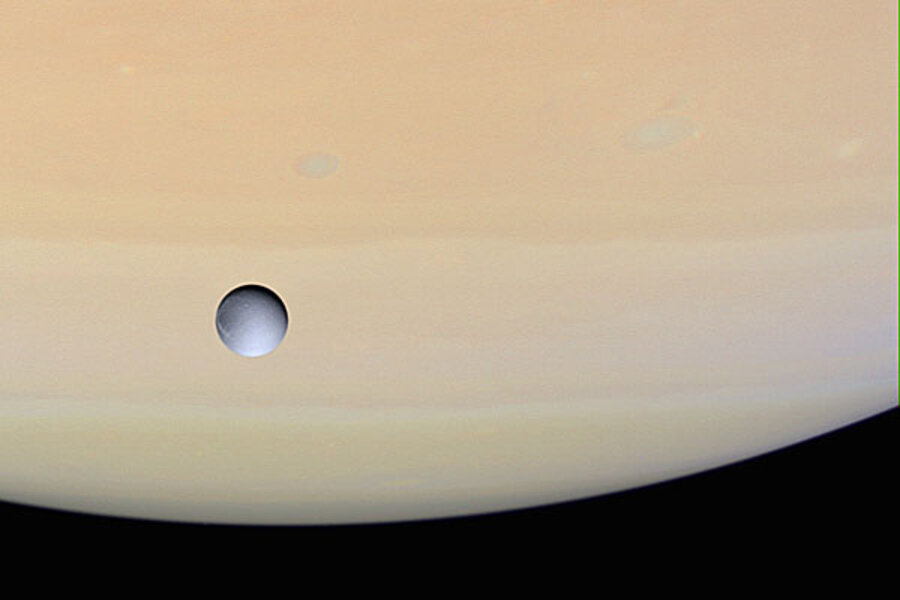Thin layer of oxygen found on Dione may change search for alien life
Loading...
Data streaming home from NASA's Cassini probe suggests that one of Saturn's largest moons, Dione, has a thin glaze of oxygen in its upper atmosphere.
In April of 2011, the probe did a close pass of Dione to confirm scientists' suspicions that the gelid moon had an atmosphere. The layer of oxygen ions is inconceivably thin, detectable only by Cassini's sensitive equipment. You'd have to travel 300 miles above the Earth's surface to find such scarce levels. (By comparison, world records in parachuting are from about 20 miles up.)
The lorn surface of Dione is pocked with craters and ancient tectonic scarring. A third the size of our own moon, Dione is an orb of frozen water compacted around a rock core. As it swings around the ringed gas giant, it is bombarded by charged particles from Saturn's bustling magnetic field. These spry particles crash into Dione's surface, upheaving ionized molecular oxygen into its thin atmosphere. Scientists call this process "sputtering."
Cassini team leader Robert Tokar of Los Alamos labs recently said in a statement that the Cassini data demonstrates that oxygen "can come from a process that doesn't involve life."
This might require scientists to rethink how oxygen ends up in an atmosphere.
Most astrobiologists agree that oxygen strongly indicates the presence of life. Oxygen is extremely reactive. It comprises a mere fifth of our own atmosphere, yet is corrosive enough to rust metal. This reactivity drastically reduces the time that molecular oxygen can exist on its own without bonding to other molecules. The reason for its noticeable presence in Earth's atmosphere is that it is cyclically replenished by specific organisms, namely plants.
The reasoning behind using oxygen as an indicator of life is simple. Nearly all living things on Earth, with the exception of some bacteria and single-celled organisms – depend on it. But astrobiologists have long recognized that this view, though pragmatic, is also narrow.
There's a sort of checklist for defining life on Earth: A certain temperature range, exposure to sunlight, access to water, manageable levels of acidity. These are biological staples for the majority of known organisms. But there are examples here on Earth that radically violate this conception of life.
These organisms have been designated "extremophiles," because of there penchants for living conditions that humans would regard as inhospitable. There are microbes on the sunless floor of the ocean that live off the heat from thermal vents. The mossy Endolith survives on trace amounts of sulfur, iron, and potassium in the arid Atacama desert, the driest place on Earth. There also exists bacteria that can persist in either the most acidic or basic conditions possible. Most impressive of all, though, is the Bold Traveler bug, discovered in 2008, a mile below Earth's surface in a gold mine. This bacteria lives in utter isolation, without light or oxygen, subsisting on fleet radioactive energy emanating from nearby uranium.
And that's just on Earth. The theories of life that propel the star-bound search for alien organisms are largely confuted before we leave the ground. Even the skeptical author of Rare Earth: Why Complex Life Is Uncommon in the Universe, Peter Ward, admitted that "once we move out in the solar system, especially in the vast realm of cold, chemistry changes. There could be different information systems, different solvents, different membranes," at a NASA's astrobiology conference in Seattle.
But astrobiologists, nonetheless, move forward. They continue to recognize that though our conception of life is increasingly tenuous, it is still the best bet we have.







